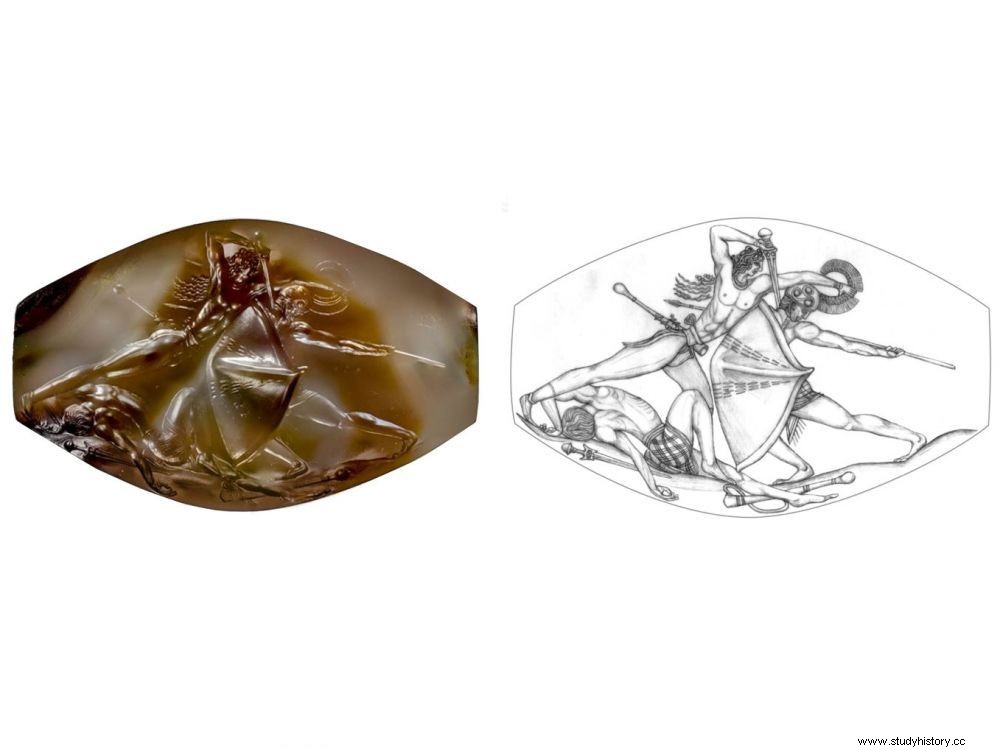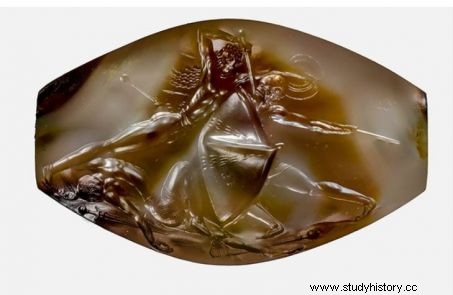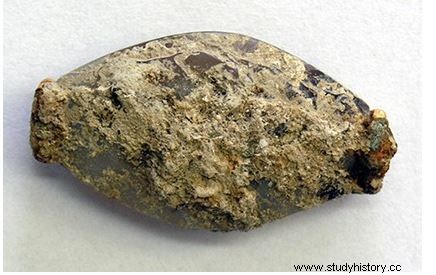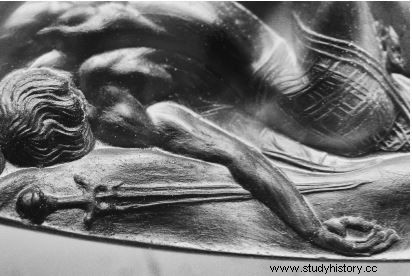A 3,500-year-old Minoan seal collected in 2015 among the treasures of the Tomb of the Warrior with the Griffin, shakes up the history of art in the Greek world.

Original and incredibly detailed reconstruction of the battle scene found engraved on a Bronze Age agate seal, barely 3.5 cm.
A delicate agate stone barely 3.6 cm wide finely decorated with a combat engraving… This exceptional work is in the process of upsetting the knowledge of specialists on the skill of artists of the Bronze Age in Greece (3200-1050 BCE).
 Due to the small size of the seal, many miniature details were only visible following photomicroscopic examinations. ©Courtesy University of Cincinnati
Due to the small size of the seal, many miniature details were only visible following photomicroscopic examinations. ©Courtesy University of Cincinnati
In an article published in the journal of classic studies Hesperia , Sharon Stocker and Jack Davis, researchers at the University of Cincinnati (United States) recently unveiled their analysis of an agate seal found among a thousand precious objects in an inviolate tomb. The discovery took place in May 2015, in an olive grove located near the ancient Mycenaean palace of Nestor, in Pylos (now Chora) in the southwestern Peloponnese, Greece. The two archaeologists unearthed one of the most extraordinary burials in the recent history of Greek antiquity, named "the griffin tomb" because of the presence of a splendid, finely carved ivory plaque of this mythical animal (read Sciences et Avenir n°826). Pieces of goldsmithery, bronze swords with ivory sheaths set with gold, jasper beads, silver cups or even a necklace and four solid gold rings had been exhumed there. All these treasures adorned the remains of a Minoan warrior - as the Greeks of Crete called themselves - or Mycenaean - Greek of the continent - buried around 1500 BC and whose identification has not been determined.
 Fighting scene depicted on an agate seal discovered in the Tomb of the Griffin Warrior, in 2015 , in Pylos, Greece. © Courtesy University of Cincinnati
Fighting scene depicted on an agate seal discovered in the Tomb of the Griffin Warrior, in 2015 , in Pylos, Greece. © Courtesy University of Cincinnati
During the exhumation, the archaeologists had also collected what appeared to be an ugly cylinder encrusted with sediment, which, after a delicate cleaning, turned out to be a jewel of glyptics, this art of cutting precious stones. “An example of fine stone engraving admirably mastered in Minoan art of the 2nd millennium “, confirms to Sciences et Avenir Sophie Descamps, curator at the Department of Greek, Etruscan and Roman Antiquities of the Louvre Museum, in Paris.
 Covered with concretions, the agate seal of Pylos at the time of its discovery. ©Courtesy University of Cincinnati.
Covered with concretions, the agate seal of Pylos at the time of its discovery. ©Courtesy University of Cincinnati.
The image of a titanic hand-to-hand combat has indeed appeared under the limestone gangue, the finesse of which has amazed the experts. "The level of detail in the depiction of weapons, clothing and bodies is second to none “, thus wrote the co-signatories of the article. Details of barely 0.045 cm for some, an extraordinary scale given the hardness of the agate stone. "Certain elements could only be visualized during the light microscopy examination !”, add the researchers.
 Detail of the engraving of the vanquished warrior, on the ground. © Courtesy Department of Classical Studies, University of Cincinnati
Detail of the engraving of the vanquished warrior, on the ground. © Courtesy Department of Classical Studies, University of Cincinnati
How could such dexterity be achieved 3500 years ago in this art of glyptics born 5000 years ago in Mesopotamia with cylinder seals? Olga Kryzskowska, the greatest specialist in Minoan seals, who teaches at the University of London (Great Britain) provides some answers:"The Middle Minoan period saw the adoption of the horizontal axis lathe, which allows you to engrave hard semi-precious stones, such as agate, rock crystal, carnelian and green jasper ..". And Sophie Descamps adds to the rarity of the object:"Less than 10% of Late Bronze Age seals represent human figures ". Few combat scenes in Aegean art from the ancient Greek mainland have been found. For the authors of the discovery, it is an object of Cretan origin. “The battle agate of Pylos may be the finest example of glyptic art discovered to date in a Minoan or Mycenaean context “, they add. As for the meaning of the scene represented, it could be a confrontation inspired by an Aegean legend. One of the great myths of the Bronze Age which, 800 years later, will be taken up by Homer in the Illiad or the Odyssey? Who knows...
Find out more:
"The Combat Agate from the Grave of the Griffin Warrior at Pylos", Hesperia :The Journal of the American School of Classical Studies, Athens , Vol.86, n°4, October-December 2017.
Synthesis on the Minoan seals published in the catalog of the exhibition “Greece of the origins. Between dream and archeology" (Saint-Germain-en-Laye, National Archaeological Museum, October 5, 2014-January 19, 2015), Paris 2014, p.108.
